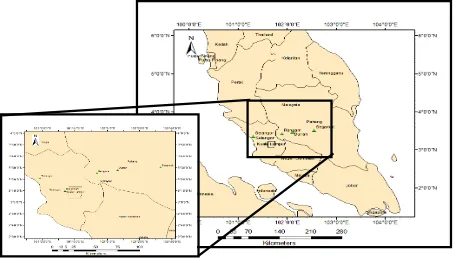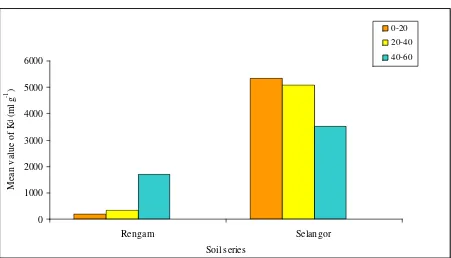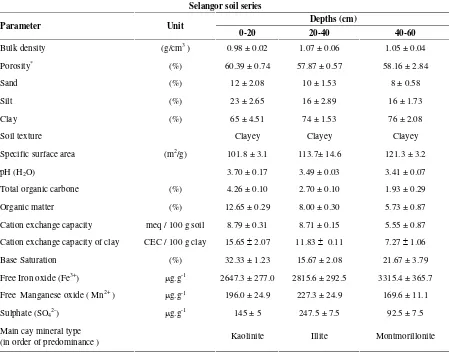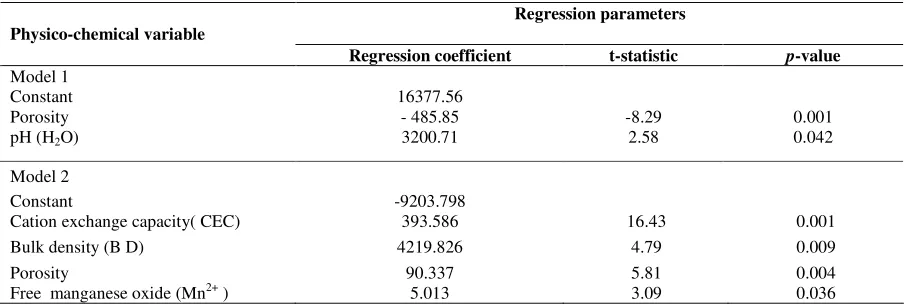Effects of Physico-Chemical Soil Properties on the Adsorption
and Transport of
137Cs in Rengam and Selangor Soil Series
Kesan Sifat Fizikokimia Terhadap Penyerapan dan Pengangkutan
137Cs
Dalam Tanah Siri Rengam dan Selangor
Zidan Mohamed M. Houmani1, Amran Ab.Majid1, Shahidan Radiman1 Zaharudin Ahmad2
1
Faculty of Science and Technology, Universiti Kebangsaan Malaysia, 43600 UKM Bangi, Selangor, Malaysia.
2Nuclear Malaysia , 43000 Bangi, Selangor D.E, Malaysia
Email address of corresponding author: houmani67@yahoo.com
Abstract
In this study, the adsorption of137Cs in soil samples were quantified using the distribution coefficient (K
d-value).
The distribution coefficients (Kd) of 137Cs in Rengam and Selangor soil series were determined by a batch
technique. The Malaysian soil series (Rengam and Selangor soil series ) were collected systematically at three different depths (0-20 cm, 20-40 cm and 40-60 cm) at two different sites in Malaysia. The batchKdtests were
used with deionized water that was spiked with 137Cs tracer to the soil sample and the activities of 137Cs in the
supernatant solution were measured by a low background but high efficiency well-type HPGe detector. Several physicochemical soil properties were also characterised for each soil type. Pearson’s correlation and stepwise multiple regression models were applied at 0.05 level of significance throughout all analysis to determine the relationships and influences between distribution coefficients (Kd-value) of 137Cs with physicochemical soil
properties of each soil type. The calculatedKd-value for Rengam and Selangor soil series at several depth were
determined to be in the range of 202 to 1739 ml.g-1and 3389 to 5919 ml.g-1respectively. The results indicate
that the stepwise multiple regression model incorporating pH and porosity influence the Kd-value of 137Cs in
Rengam Soil Series and exhibits anR2equal to 0.922 indicating that 92.2% of total variation has been explained by the regression model. The regression model also reveals that cation exchange capacity, bulk density, porosity and free manganese oxide (Mn2+) have influence on the
Kd-values of137Cs in Selangor soil series and exhibits
anR2equal to 0.997 indicating 99.7 % of total variation. Therefore, the sorption coefficients in relation to the environmental factors including physicochemical properties can be used to predict and design the radionuclide transport and safety assessment models.
Keywords:Kd-value,137Cs, physicochemical soil properties
Kata kunci: NilaiKd,137Cs, sifat fizikokimia tanah
Abstrak
Dalam kajian ini, penyerapan137Cs dalam sampel tanih telah dikuantitikan dengan menggunakan Kaedah Pekali
Taburan (Nilai Kd). Pekali Taburan (Kd) 137Cs bagi siri tanih Rengam dan Selangor telah ditentukan
menggunakan teknik kelompok. Siri tanih Rengam dan Selangor telah dikumpulkan secara sistematik pada tiga kedalaman yang berbeza (0-20 cm, 20-40 cm dan 40-60 cm) di dua lokasi yang berlainan di Malaysia. Nilai Kd
ditentukan menggunakan air ternyahion yang ditambahdengan penyurih137Cs kepda sampel tanih. Aktiviti137Cs
tetapi kecekapan yang tinggi. Beberapa sifat fisikokimia tanih juga telah dicirikan bagi setiap jenis tanih. Korelasi Pearson dan Model Regresi Berganda Berperingkat turut digunakan pada tahap signifikan 0.05 untuk keseluruhan analisis bagi menentukan hubungan dan pengaruh antara pekali taburan (nilai Kd)137Cs dengan sifat
fisikokimia bagi setiap jenis tanih. Nilai Kd yang telah dikira untuk masing-masing siri tanihRengam dan
Selangor dicatatkan dalam julat 202 hingga 1739 ml g-1dan 3389 hingga 5919 ml g-1. Keputusan menunjukkan
bahawa model regresi berganda berperingkat menggabungkan pH dan keliangan mempengaruhi nilai Kd137Cs
bagi tanih siri Rengam dan mempamerkanR2bersamaan dengan 0.922 yang mana menunjukkan 92.2 % dari jumlah variasi telah diterangkan oleh model regresi. Model regresi juga menunjukkan bahawa kapasiti pertukaran kation, ketumpatan pukal, keliangan dan mangan oksida bebas (Mn2+) dapat mempengaruhi nilai K
d 137Cs dalam tanih siri Selangor dan mempamerkan R2 bersamaan 0.997 yang menunjukkan bahawa 99.7 % daripada jumlah variasi. Maka kajian ini mendapati pekali penyerapan yang berkaitan dengan faktor sekitaran termasuklah sifat fisikokimia boleh digunakan untuk meramal dan merekabentuk pengangkutan radionuklid dan model penilaian keselamatan.
Introduction
Cs is one of the important radionuclides for several reasons: it shows the almost unlimited solubility in the inventory of radioactive waste is significant [1]. A radioisotopes of cesium, 137Cs is relatively resistant and
provides important problems radioecologically [2]. The main sources of soil contamination are global fallout of
137Cs from the atmosphere as a result of atmospheric testing of nuclear weapons, surface and underground
nuclear explosions and accidental releases from nuclear facilities. In addition to these main sources of137Cs soil
contamination, there have been few cases of local contamination which could increase the radiation dose to the population in surrounding areas[3]. In addition, because of its chemical similarity to K, Cs is easily assimilated by terrestrial and aquatic organisms [1]. The study of sorption of pollutants in soil is of great interest in terms of ecological and agricultural. It is known that ion exchange reactions occur mainly between Cs ions and clay minerals. The bioavailability of Cs+in natural systems depends largely on the adsorption properties of the solid
phase [4].Radionuclides present in soil have the potential to be released or leached to the groundwater. In order to understand the way in which radioactive contamination may be transferred from soil to plants, animals and finally to man, it is useful to have a basic knowledge on both the physical and chemical properties of soils and the mechanisms by which radionuclides are passed from the soils to the food chain or the means that lead to the contamination of water supplies [5]. The primary objective of the present study is to determine the effects of physico-chemical soil properties on adsorption of137Cs in Rengam and Selangor soil series . Such study could
assist future environmental study such as environmental radiological impact assessments (RIA) in the future. One of the important factors that needs to be considered in RIA is the possible release or leaching of radionuclides into ground water.
(Kd), which is the ratio of the amount of the radionuclide sorbed by the solid (g g-1) divided by the concentration
in the equilibrium solution (g ml-1). The
Kd-value is commonly used as a means of assessing the mobility of
radionuclides in the environment and for comparing adsorption data obtained from different sources [7].The parameter known as (Kd-value) is defined as the ratio of the concentration of the radionuclide bound to soil to the
concentration in the pore water. The value of Kddepends on the type of radionuclides, physico-chemical soil
properties and mineralogy of the soil, The Kd-value of the radionuclides needs to be determined in order to
estimate the transport or leaching potential used to assess associated risks.
Materials and Methods Soil sampling and preparation
The studied soil were Rengam and Selangor series, Typic Kandiudult and Typic Endoaquepts, respectively [6]. Undisturbed soil samples were taken from the designated sampling stations shown in Figure 1. First, the detritus (grass and litter) at each sampling station were cleared from the ground surface and the soil was dug with a spade. Soil samples were collected from depths of 0-20 cm, 20-40 cm and 40-60 cm. About 500 g soil samples were collected from each depth. The samples were sealed in plastic bags and taken to the laboratory for further analysis. In the laboratory, the samples were air dried at room temperature, disaggregated using a wooden mortar and pestle and sieved through a 2 mm mesh for further use and analysis. In addition, soil cores (7.6 cm diameter and 4 cm long) were also taken from each depth for bulk density determination.
Figure 1. Location of soil sampling stations of Rengam and Selangor soil series
Determination of physico-chemical soil properties and soil clay mineralogy
difference between the soil particle density and bulk density, while particle size distribution was determined by the Pipette method, together with dry sieving [8]. The texture of the soils was obtained by plotting their percentages of sand, silt and clay and categorized using the triangular texture map. Soil bulk densities (g/cm3)
were derived by dividing the mass of the dried soil cores by their volumes [9].
The pH was measured using a pre calibrated lab-top pH meter equipped with a glass electrode in an aqueous suspension of 10 g of dry soil and 25 ml of distilled water (1:2.5,w/w), shaken for 30 minutes in a conical flask [10]. Exchangeable acid ions (Al3+and H+) were measured in 1.0 M KCl extract by titration. Exchangeable base
cations were measured in 1.0 M ammonium acetate extract by Flame Atomic Absorption Spectrophotometer (FAAS, model Perkin Elmer 3300) and cation exchange capacity (CEC) was obtained by summation of the acid and base cations. The base saturation was calculated by the equation [sum cations / CEC]100]. The extractable free Fe- and Mn-oxides contents were determined by the dithionite-citrate method [11]. Sulphate contents were measured on a sediment water extract [1 g :10 mL] after two hours of shaking and filtration using the barium sulphate turbidometric procedure [12]. The specific surface area was determined by the ethylene glycol monoethyl ether (EGME) method [13]. Organic carbon was estimated using the Walkley and Black method and organic matter (OM) was calculated by multiplying the values of organic carbon by 1.72 [14].
For identification of clay minerals in the bulk soil samples, X-ray diffraction (XRD) analysis was performed using a Siemens D500 powder X-ray diffractometer using CuKradiation, and operated at 40 kV and 30 mA. The oriented specimens were scanned from 3 to 35 degrees 2. All samples were prepared for both qualitative and quantitative determination by X-ray diffraction analysis according to the general procedure of Moore and Reynolds [15]. About 1g of soil was placed into 10-ml measuring cylinder. About 5 ml of distilled water was then added in to it and was mixed thoroughly using a glass rod. After 15-20 minutes, the upper solution was then pipetted (using an eyedropper) and placed slowly on the clean glass slide so that the liquid covered the entire surface of the slide. It was assumed, according to Stoke’s Law, that the solution that was sampled contained the clay particles of less than 2μm. The slide was dried at the room temperature. High drying temperature was not used to avoid any damage to poorly crystallised clay minerals in soils. Several treatments have been undertaken to verify the clay minerals in the soil.
Laboratory sorption experiments
The sorption of137Cs on Rengam and Selangor soil series were studied by batch technique using at least three
replicates. The solution-soil ratio was maintained as 20:1 throughout the experiments in accordance with ASTM D4319-93 [16]. Twenty 20 ml of 1788.570 Bq ml-1 137Cs was spiked into deionised water. The spiked solutions
were mixed with 1.0 0.1 g of the soil in 50-cm3polyethylene centrifuge tubes with screw caps and septum sealed. Suspensions were initially preconditioned, using deionised water with on137Cs spike by shaking for 24 h
at 23±20C using an end-over-end shaker. The mixture was shaken for 7 days to achieve the equilibrium of137Cs
detector (GCW 2523) with active volume of 155 cm3, a relative photopeak efficiency of 25%, and a resolutions
at the 1332 keV energy of60Co of 2.3 keV (FWHM).
Kd(ml g-1) was then calculated using equation
1:-M
Where Ci (Bq ml-1) is initial activity of the radiotracer in the aqueous phase, Cf (Bq ml-1) is activity of
radiotracer in the final supernatant, V is solution volume (20 ml), and M is soil dry weight (1.00.01 g).
Treatment of the raw counting data was performed with the GENIE 2000 program. The activity (cps) of the137Cs
photopeak (661.6 keV) was determined. Based on the background and blank counts, the minimum detectable activity (MDA) for this geometry was derived using Currie’s Method formula [17]:
),
Where, is statistical coverage factor (= 1.645) (P ≤ 0.05), B is background radiation of the radionuclide of interest, is counting efficiency of the detector, P is absolute transition probability of -decay, W is dried sample weight in g, andT iscounting time in seconds. The MDA for137Cs determined was 2.087 Bq kg−1.
Data analysis
In the data analysis, the soil’s physical and chemical properties were considered as independent factors while the observed adsorption of 137Cs was considered as the one dependent factor. The coefficient of correlations and
stepwise multiple regressions were calculated to determine the independent factors which were significantly controlled with the dependent factor. The statistical significance was considered at significant level 0.05 (α = 0.05). Therefore, we considered that the regression models and coefficients correlations of the 5% or less chance of error (p ≤ 0.05). Data analysis was performed using the statistical software Statistical Package for Social Sciences (SPSS) Ver.15.0. Assuming that the data were normally distributed, significant differences were considered at p ≤ 0.05. Pearson’s correlation and a stepwise multiple linear regression technique was used to derive the relationship and influences between physico-chemical soil properties and distribution coefficients (Kd
-value).
Results and discussions
The results ofKd-experiments on two Malaysian soil types are shown in Table 1 and Figure 1 . The range ofKd
-Cs values of these Malaysian soil series were determined to be between 202 ml g-1to 1739 ml g-1and 3389 ml g -1 to 5919 ml g-1for Rengam and Selangor soil series, respectively. The results also showed that theK
d-value of 137Cs dependeds on the depths of soil. The results showed that theK
d-value of137Cs is higher as the depth of soil
as the soil depth increased. The remarkable difference in Kdvalues of the Rengam and Selangor soil series can
be attributed to be influenced by number of factors including soil texture, pH, porosity etc (Table 2 and 3).
Table 1. Mean of distribution coefficients (Kd-value) for137Cs in Rengam and Selangor soil series
Rengam Selangor
Figure 2.137Cs adsorption onto Rengam and Selangor soils series
Table 2. Physico-chemical and mineralogical characteristics of Rengam soil series
Rengam soil series
Depths (cm)
Parameter Unit
0-20 20-40 40-60
Bulk density (g/cm3) 0.98±0.02 1.06±0.02 1.10±0.03
Porosity* (%) 60.28±0.49 59.58±0.91 57.37±0.44
Sand (%) 57±0.58 50±0.6 48±1
Silt (%) 16±0.58 13±1.2 12±1.15
Clay (%) 27±1 37±0.6 40±0.58
Soil texture Sandy clay loam Sandy clay Sandy clay
Specific surface area (m2/g) 77.2±7 88.1±9.5 94.1±0.9
Total organic carbone (%) 1.89±0.20 0.65±0.06 0.45±0.13
Organic matter (%) 5.59±0.59 1.93±0.17 1.33±0.38
Cation exchange capacity meq / 100 g soil 5.62±0.15 6.00±0.57 5.99±0.79 Cation exchange capacity of clay CEC / 100 g clay 20.85 ± 0.95 16.36 ±1.54 15.12 ± 2.20
Base Saturation (%) 13.00±2.65 7.67±2.08 5.33±0.58
Free Iron oxide (Fe3+) g.g-1 5021.1±481.5 5696.4±486.7 6094.4±611.4
Free Manganese oxide ( Mn2+)
g.g-1 142.1±28.3 121.6±43.8 120.2±62.8
Sulphate (SO42-) g.g-1 35 ± 0 47.5 ± 2.5 22.5 ± 2.5
Main cay mineral type
(in order of predominance ) Kaolinite Illite Montmorillonite
*Porosity calculated based on soil particle density of 2.65 g /cm3and soil bulk density value; meq: milli-equivalents.
Table 3. Physico-chemical and mineralogical characteristics of Selangor soil series
Selangor soil series
Depths (cm)
Parameter Unit
0-20 20-40 40-60
Bulk density (g/cm3) 0.98 ± 0.02 1.07 ± 0.06 1.05 ± 0.04
Porosity* (%) 60.39 ± 0.74 57.87 ± 0.57 58.16 ± 2.84
Sand (%) 12 ± 2.08 10 ± 1.53 8 ± 0.58
Silt (%) 23 ± 2.65 16 ± 2.89 16 ± 1.73
Clay (%) 65 ± 4.51 74 ± 1.53 76 ± 2.08
Soil texture Clayey Clayey Clayey
Specific surface area (m2/g) 101.8 ± 3.1 113.7± 14.6 121.3 ± 3.2
pH (H2O) 3.70 ± 0.17 3.49 ± 0.03 3.41 ± 0.07
Total organic carbone (%) 4.26 ± 0.10 2.70 ± 0.10 1.93 ± 0.29
Organic matter (%) 12.65 ± 0.29 8.00 ± 0.30 5.73 ± 0.87
Cation exchange capacity meq / 100 g soil 8.79 ± 0.31 8.71 ± 0.15 5.55 ± 0.87
Cation exchange capacity of clay CEC / 100 g clay 15.652.07 11.83 0.11 7.271.06
Base Saturation (%) 32.33 ± 1.23 15.67 ± 2.08 21.67 ± 3.79
Free Iron oxide (Fe3+)
g.g-1 2647.3 ± 277.0 2815.6 ± 292.5 3315.4 ± 365.7
Free Manganese oxide ( Mn2+) g.g-1 196.0 ± 24.9 227.3 ± 24.9 169.6 ± 11.1
Sulphate (SO42-) g.g-1 145 ± 5 247.5 ± 7.5 92.5 ± 7.5
Main cay mineral type
(in order of predominance ) Kaolinite Illite Montmorillonite
Table 4 reports the regression result betweenKd-value of 137Cs of Rengam soil series and physico-chemical soil
parameters. The final137Cs
Kdmodel uses two independent variables, porosity and pH and exhibits anR2equal to
0.922 indicating that 92.2% of total variation has been explained by the regression model. The final regression model
is:-Kd-value of137Cs = 16377.562 - 485.848porosity + 3200.708 pH (3)
Base on the objective of this study, correlation analysis was followed by stepwise multiple regression analysis in order to verify the correlation. From the final equation model described above, the porosity is a negative influencing parameter on Kd-Cs-value and pH has positive influence on Kd-Cs-value in Rengam soil series. One of largely
influencing parameter related to porosity is a factor of particle (grain) size. Statistical data reveals that there is a negative relationship between porosity with clay and porosity with bulk density. Clay soils exhibit a variety of micropores and macropores which may hold water contents and control the filtration rates. [18]. The Cs sorption is related to the pH of the soil because of its nature of charge density at specific value. The equation A determines the pH factor as a significant parameter to evaluate the sorption. It is reported that the maximum Cs sorption was observed at higher pH, when the negative charge density on the surface of absorbents was highest [19]. Therefore, The pH influence found agreed with the findings reported by Kami-Ishikawa et al for the clayey nature of soils.As the acidic conditions are concerned, the availability of cations may create competition with other cations for the available sorption sites [20].
Table 4 presents the regression model between physic chemical soil properties andKd-value of137Cs of Selangor soil
series. The final 137Cs
Kd model was established using four independent variables including cation exchange
capacity, bulk density, porosity and free manganese oxide (Mn2+) which exhibits an
R2equal to 0.997 indicating 99.7 % of total variation as mentioned in equation B. The final regression model
is:-Kd-value of137Cs = - 9203.798 + 393.586CEC + 4219.826B.D + 90.337porosity + 5.013Mn (4)
Where CEC is cation exchange capacity, B.D is bulk density.
Table 4. Regression summary forKd-value of137Cs of Rengam and Selangor soil series respectively
Regression parameters Physico-chemical variable
Regression coefficient t-statistic p-value Model 1
Constant 16377.56
Porosity - 485.85 -8.29 0.001
pH (H2O) 3200.71 2.58 0.042
Model 2
Constant -9203.798
Cation exchange capacity( CEC) 393.586 16.43 0.001
Bulk density (B D) 4219.826 4.79 0.009
Porosity 90.337 5.81 0.004
It can be concluded from the final equation model described as Eq 4, the cation exchange capacity, bulk density, porosity and free manganese oxide (Mn2+) have positive effect on
Kd-Cs-value in Selangor soil series. It is fact that
the cation exchange capacity influence on the adsorption of137Cs due to its ion exchange characteristics. The CEC
value strongly depends on the clay content and thus the relationship between theKd-value and CEC will be similar to
but weaker than that for theKdvalue and the clay content [21].The bulk density and porosity have influence on the
adsorption of137Cs due to their relation with the permeability of the contents to perform sorption. The small pore size
and high density may not allow the contents for migration to create the negative influence and vice versa. The free manganese oxide (Mn2+) influence positively on the adsorption of 137Cs due to its ability to adsorb the Cs. It may
provide the binding sites for the incorporation of Cs to migrate through the channels in the soil. Hasany and Chaudhary (1984) have reported the adsorption of137Cs on MnO2under different conditions of physical parameters
[22].
Conclusions
The study results suggest that Cs-Kdwas affected by several soil properties, such as pH, porosity in Rengam soil
series and bulk density, cation exchange capacity and free manganese oxide (Mn2+) in Selangor soil series. The
study signified that the Rengam and Selangor soil series have good sorption for137Cs radionuclide. The distribution
and migration of Cs in the soil depends in particular on its physicochemical properties and the movement of soil water with associated contents. The transport of the Cs in the soil is determined by the amount of absorbed Cs and other soil properties including texture, porosity and organic contaminants. The adsorption properties have also relation with the type and composition of the clay mineral content of the soil. This study has revealed some trends of sorption in relation to the nature of soil texture and other physicochemical properties and the data could be used in radionuclide transport and safety assessment models.
Acknowledgements
The authors would like to thank Mr. Yii from the Malaysian Nuclear Agency for his invaluable guidance and assistance during the experimental work of137Cs measurements by the well-type HPGe detector, We are also grateful
to Dr. Sahibin Abd. Rahim from the School of Environmental and Natural Resource Sciences, FST, UKM, for his advice on the physico-chemical properties of Selangor soil series
References
1. Poinssot, C., Baeyens, B., &Bradbury, M. H. (1999). Experimental and modelling studies of caesium sorption on illite.Geochimica et Cosmochimica Acta63 (19-20):3217-3227.
2. Staunton, S., & Roubaud, M. (1997). Adsorption of 137Cs on montmorillonite and illite: Effect of charge compensating cation, ionic strength, concentration of Cs, K and fulvic acid. Clays and clay minerals 45 (2):251-260.
3. Nabyvanets, Y. B., Gesell, T. F., Jen, M. H., &Chang, W. P. (2001). Distribution of 137Cs in soil along Ta-han
4. Atun, G., & Kilislioglu, A. (2003). Adsorption behavior of cesium on montmorillonite-type clay in the presence of potassium ions.Journal of Radioanalytical and Nuclear Chemistry258 (3):605-611.
5. Eisenbud, M. (1973).Environmental radioactivity. 2nded,Environmental sciences. New York,: Academic Press.
6. Paramananthan, S. (2000). Soils of Malaysia. Their Characteristics and Identification. Vol. 1.Academy of Sciences Malaysia, Kuala Lumpur.
7. Sheppard, M. I., & Thibault, D. H. (1990). Default soil solid/partition coefficients, Kds, for four major soil types:
A compendium.Health Physics59 (4):471- 482.
8. Day, P. R. (1965). Particle fractionation and particle-size analysis. InMethods of soil analysis, Part 1edited by Black, C. A., Evans, D. D., White, J. L., Ensminger, L. E. &Clark, F. E. Madison: American socity of Agronomy.
9. Blake, G. R. (1965). Particle density,Bulk density. InMethods of soil analysis, edited by Black, C., Evans, D. D., Ensminger, L. E., White, J. L. &Clark, F. E. Madison: American Society of Agronomy.
10. Metson, A. J. (1956). Methods of chemical analysis for soil survey samples. Vol. 12. Wellington: Dept. of Scientific Industrial, Research.
11. Carter, M. R. (1993).Soil sampling and methods of analysis. Boca Raton: Lewis Publishers.
12. HACH. (1996). Spectrophotometer Instrument Manual. For use with the software Ver. 3. Loveland Colorado: HACH Company.
13. Wan Zuhairi, W. Y. Access (2006).SSA based on EGME method 2006 [cited 27/11/2006 2006]. Available from
http://pkukmweb.ukm.my/~zuhairi/Pengajaran/intranet/e-library/Soil%20lab/Specific%20surface%20area.pdf.
14. Walkley, A., & Black, I. A. (1934). An examination of the Degtjareff method for determining organic carbon in soils: Effect of variations in digestion conditions and of inorganic soil constituents. Soil Science 63:251-263.
15. Moore, D. M., & Reynolds, R. C. (1997). X-Ray Diffraction and the Identification and Analysis of Clay
Minerals,. 2nded. New York: Oxford University Press.
16. ASTM. (1984). Standard Test Method for Distribution Ratios by the Short-Term Batch Method. InAnnual Book of ASTM Standards: American Society for Testing and Materials.
17. Currie, L. A. (1968). Limits for qualitative detection and quantitative determinationAnal Chem40:586-593.
18. Munshower, F. F. (1994).Practical handbook of disturbed land revegetation. Florida: Lewis.
19. Giannakopoulou, F., Haidouti, C., Chronopoulou, A., &Gasparatos, D. (2007). Sorption behavior of cesium on various soils under different pH levels.Journal of Hazardous materials149 (3):553-556.
20. Kamei-Ishikawa, N., Uchida, S., &Tagami, K. (2008). Distribution coefficients for 85Sr and 137Cs in Japanese
agricultural soils and their correlations with soil properties. Journal of Radioanalytical and Nuclear
Chemistry277 (2):433-439.
21. Shenber, M. A., & Eriksson, Å. (1993). Sorption behaviour of caesium in various soils.Journal of Environmental
22. Hasany, S., & Chaudhary, M. (1984). Adsorption behaviour of microamounts of cesium on manganese dioxide.



